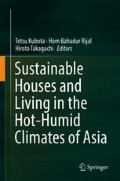Abstract
Human beings have a natural instinct for bio-climatic home building. Vernacular architecture potentially leverages on this ability while responding to the sociocultural and economic needs of a population. India is a peninsula with a long coastline. A predominantly warm country, India has about 80% of the land under composite and warm-humid climates. This chapter navigates through the bio-climatic vernacular architecture of various climatic zones of India, emphasizing the warm-humid zones. It also provides examples that imbibed the bio-climatic spirit in creating a modern vernacular.
Access this chapter
Tax calculation will be finalised at checkout
Purchases are for personal use only
References
Heschong L (1979) Thermal delight in architecture. MIT Press, Cambridge, MA
BEE (2007) Energy Conservation Building Code, India
Gupta RR (2013) The Wada of Maharashtra, an Indian Courtyard House Form (PhD thesis). Cardiff University, UK/Ann Arbor, MI, Proquest LLC. http://orca.cf.ac.uk/55688/1/U584207.pdf
Dili AS, Naseer MA, Varghese TZ (2010) Passive environment control system of Kerala vernacular residential architecture for a comfortable indoor environment: A qualitative and quantitative analyses. Energ Build 42:917–927
Priya SR, Sundarraja MC, Radhakrishnan S, Vijayalakshmi L (2012) Solar passive techniques in the vernacular buildings of coastal regions in Nagapattinam, TamilNadu-India – a qualitative and quantitative analysis. Energ Build 49:50–61
Al-Hinai H, Batty WJ, Probert SD (1993) Vernacular Architecture of Oman: Features That Enhance Thermal Comfort Achieved Within Buildings. Appl Energ 44:233–258
Indraganti M (2010) Understanding the climate sensitive architecture of Marikal, a village in Telangana region in Andhra Pradesh, India. Build Environ 45(12):2709–2722
Saleh MAE (1999) Al-Alkhalaf: the evolution of the urban built-form of a traditional settlement in Southwestern Saudi Arabia. Build Environ 34:649–669
Rewal R, Veret JL, Sharma R (1985) The relevance of tradition in Indian Architecture. In: Architecture in India. Milan/Paris: Electa Moniteur, pp 12–23
Kumar A, Pushpalata (2013) Vernacular practices: as a basis for formulating building regulations for hilly areas. Int J Sustain Built Environ 2(12):183–192
Acknowledgments
Swarna and Murali Chanduri of Claremont, CA, USA provided the funds used for the Marikal studies through a personal grant organized via Telugu Association of Los Angeles (TELSA), USA. Nidhi Kotak Doshi, Ravi Kumar, Reema Ghosh, and Ritu Ahal from India have generously supplied some of the images. I thank all of them.
Author information
Authors and Affiliations
Corresponding author
Editor information
Editors and Affiliations
Rights and permissions
Copyright information
© 2018 Springer Nature Singapore Pte Ltd.
About this chapter
Cite this chapter
Indraganti, M. (2018). India: Bio-climatism in Vernacular Architecture. In: Kubota, T., Rijal, H., Takaguchi, H. (eds) Sustainable Houses and Living in the Hot-Humid Climates of Asia. Springer, Singapore. https://doi.org/10.1007/978-981-10-8465-2_5
Download citation
DOI: https://doi.org/10.1007/978-981-10-8465-2_5
Published:
Publisher Name: Springer, Singapore
Print ISBN: 978-981-10-8464-5
Online ISBN: 978-981-10-8465-2
eBook Packages: Earth and Environmental ScienceEarth and Environmental Science (R0)

